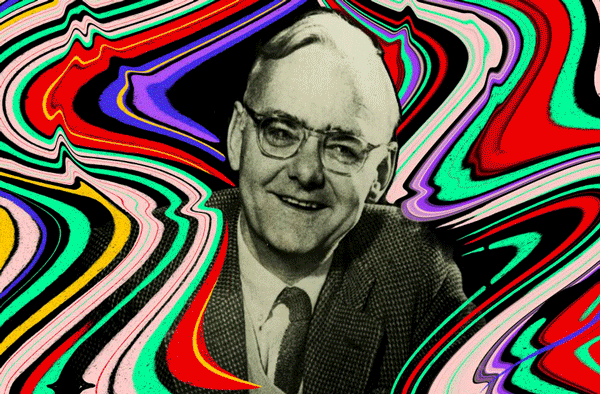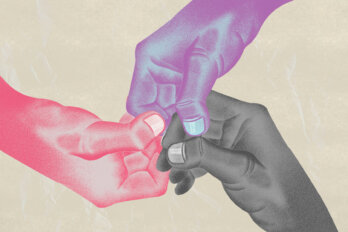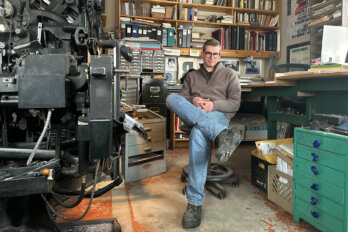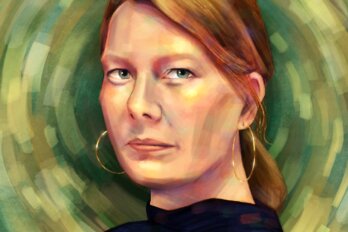In the fall of 1951, Humphry Osmond, a thirty-four-year-old British psychiatrist, travelled from London to Weyburn, Saskatchewan, to become the clinical director of the town’s mental hospital. About 110 kilometres southeast of Regina, Weyburn was a small community in the middle of nowhere, and its grubby, ill-equipped hospital was sometimes referred to as the last asylum in the British Commonwealth. The building was a mess, and it wasn’t uncommon for its ceilings to be spattered with patients’ feces. “Screams, stench, nudity—it was a place to keep out of your dreams,” was how Osmond poetically described it. But this prairie outpost was also a haven.
Back in London, Osmond had become fascinated by hallucinogenic drugs, particularly LSD and mescaline, which is found in the peyote cactus. He thought that these substances had the potential to unlock the mysteries of mental illnesses, but the British psychiatric community, still enthralled by Freud and psychoanalysis, was dismissive of Osmond’s outré biochemical theories. Saskatchewan, in contrast, was a hospitable place for new ideas of all kinds: it had the first democratic socialist government in North America, and the groundwork was being laid for the creation of medicare. Tommy Douglas’s CCF government had begun to reform hospital conditions, administration, and training, and it had also initiated a massive recruitment drive in medicine, bringing in the best researchers from around the world and granting them almost unlimited freedom and resources. Osmond was one of those researchers, and at Weyburn—initially, at least—he was considered a visionary.
Along with his colleagues John Smythies and Abram Hoffer, Osmond found that mescaline produces symptoms that are almost identical to schizophrenia, and he hypothesized that the drug could be used to essentially induce schizophrenic symptoms in healthy patients in order to help develop treatments for the illness. Osmond later experimented with LSD, finding particular success in using it to treat alcoholism. What Osmond realized was that the drugs’ promise wasn’t due to their ability to mimic madness but rather their ability to do something more nebulous, less quantifiable, and more revolutionary: induce a radical reorientation in what users saw, felt, and thought. As anyone who’s taken psychedelics knows, the drugs can refresh and enlarge the world even as they provide a glimpse of other meaningful worlds.
In March 1953, the novelist and philosopher Aldous Huxley read an article by Smythies and Osmond that detailed their mescaline experiments. He sent Osmond an “appreciative note,” along with a copy of his novel The Devils of Loudun. A decade-long friendship instantly blossomed between the two English expats—Huxley was then living in Los Angeles—and they began a correspondence. When Osmond visited California a few months later, he administered Huxley his first dose of mescaline. Huxley immortalized this life-changing event in his next book, The Doors of Perception, which would quickly become countercultural scripture. “By taking the appropriate drug,” Huxley wrote, “I might so change my ordinary mode of consciousness as to be able to know, from the inside, what the visionary, the medium, even the mystic were talking about.”
Osmond’s work in Saskatchewan, and his influence on and relationship with Huxley, are the subjects of two new (and similarly titled) books: historian P.W. Barber’s Psychedelic Revolutionaries: LSD and the Birth of Hallucinogenic Research and Psychedelic Prophets: The Letters of Aldous Huxley and Humphry Osmond, which is edited by six keepers of the Osmond-Huxley flame (Cynthia and Paul Bisbee, Erika Dyck, Patrick Farrell, James Sexton, and James W. Spisak). Taken together, the two texts form a fulsome portrait of this perennially fascinating period in Canadian medical history, with Barber’s sober, analytic account brought to life by the lively archive of Osmond-Huxley letters, which span from 1953 until Huxley’s death in 1963.
As both books make clear, psychedelics have frequently been maligned in both the scientific community and mainstream culture. But new medical research and a more capacious understanding of the drugs have started to shift opinions. The enormous possibilities that Osmond, Huxley, and their fellow travellers saw in these substances are being reconsidered by everyone from doctors to business executives to politicians. Going back to 1950s Saskatchewan might not exactly be a trip back to the garden, but the lessons of that period can certainly help guide us through what has now been dubbed the new psychedelic renaissance.
That phrase, “psychedelic renaissance,” comes from journalist Michael Pollan, whose 2018 bestselling book, How to Change Your Mind: What the New Science of Psychedelics Teaches Us About Consciousness, Dying, Addiction, Depression, and Transcendence, both amplifies and anatomizes our current moment. Pollan looks at how LSD and psilocybin (the active ingredient in magic mushrooms) can be used to treat everything from serious mental illnesses to everyday personal challenges. It came out alongside several other texts, including Tao Lin’s Trip and Ayelet Waldman’s A Really Good Day—both of which offer very different, and very detailed, accounts of their authors’ positive experiences with psychedelics (psilocybin and DMT in Lin’s case and LSD in Waldman’s).
Not coincidentally, these books appeared alongside a burst of scientific interest in psychedelics’ potential to heal depression, anxiety, and addiction. Last September, London’s Imperial College launched the first placebo-controlled trial of LSD microdosing (that is, taking doses large enough to have positive effects but small enough that they don’t produce a noticeable high). That same month, researchers in Canada, the United States, and Israel began FDA-regulated trials of MDMA-assisted psychotherapy for posttraumatic stress disorder. More broadly speaking, the legalization of cannabis in Canada and the recent call for the legalization of all drugs by Toronto’s medical officer of health suggests that we may, at last, be living in a climate where not only will drugs be tolerated but their positive aspects will be celebrated.
There may be a number of reasons for this sudden resurgence. More sophisticated medical imaging has given us a better map of the brain, and we know much more about the body’s complex chemistry. The war on drugs, now almost fifty years old, has predictably failed to curb our ancient affection for both intoxication and self-derangement. There’s also greater awareness of, and interest in, Indigenous cultures in which several psychedelics are considered sacramental. In an era of lethal street drugs of uncertain strength and ingredients, traditional psychedelics—particularly those directly derived from plants—may no longer seem quite as dangerous; they feel almost pure and authentic, like organic vegetables or craft beer. And, finally, in an era of spiritual confusion and apocalyptic politics, psychedelics once again hold out a promise of both solace and transcendence. A better, or at least radically different, world, they say, is possible.
It’s the same world, more or less, that Osmond and Huxley were looking for in the 1950s. What makes the pair’s insights vital now is that they represent a prelapsarian era of psychedelic investigation, one characterized as much by caution as by enthusiasm. As Barber’s Psychedelic Revolutionaries chronicles well, and in a measured tone that accurately reflects Osmond and Huxley’s judicious perspectives, these early psychonauts were extremely aware of, even awed by, the power of the chemicals they were studying and, at times, ingesting. For them, these drugs were not to be taken lightly.
Early in Psychedelic Revolutionaries, Barber recounts an exchange concerning LSD between Osmond and his like-minded colleague Abram Hoffer: “We appear to have stumbled upon a way of chemically dissecting a person’s psyche,” Hoffer writes, and he notes the “vast philosophical and psychological implications” of this discovery. The introduction to the Osmond-Huxley letters in Psychedelic Prophets follows a similar vein, explaining that the two viewed psychedelics “as very powerful substances to be respected, not abused, and to be experienced during a ritualized ceremony, not simply in a casual encounter.” In October 1956, Osmond took part in a ceremony of precisely this kind. He and a few colleagues were invited to a peyote ceremony near North Battleford, Saskatchewan, hosted by the Native American Church of North America. Barber writes that it was one of the first documented times that non-Indigenous men had been involved in such a ceremony in Canada, and the experience confirmed Osmond’s esteem of the drug: “Peyote, like anything else that contains a powerful chemical substance, should be handled with respect,” he later wrote. “It can be no danger to a responsible person and may broaden and enlarge the mind.” Even in coining the very word psychedelic—which he did in a 1956 poem that he sent to Huxley—Osmond acknowledged the drugs’ mystical potency: “To fathom Hell or go angelic / just take a pinch of PSYCHEDELIC.”
But despite Osmond and Huxley’s cautious, even reverential, attitude, these drugs were quickly stigmatized by the wider world. By the early 1960s, Barber writes, “there was already a consensus brewing within psychiatry that psychedelics were too dangerous and had no place inside or outside the field.” Psychiatrists at the University of British Columbia and at the American Medical Association publicly attacked the Saskatchewan research, arguing that LSD precipitated psychoses and had negligible therapeutic value. Barber argues, however, that these doctors had no actual experience with the drug and had lashed out because they were threatened by the paradigm shift that the Saskatchewan research represented—the age-old problem of the avant-garde in every field: “Unlike other psychopharmacological therapies, psychedelic therapy, with its overt mysticism and emphasis on subjective patient experiences and values, did not fit neatly within the new objective world of ‘scientific psychiatry’ and evidence-based medicine.”
Osmond and company had another problem: at Harvard, a middle-aged psychologist named Timothy Leary had also begun experimenting with psilocybin. Though Leary had consulted extensively with Huxley (then a guest lecturer at MIT) and eventually met Osmond, whose work he came to admire, he had different opinions on the usage of the drugs. While Osmond recognized the potential good that psychedelics could do for all of humanity, he also felt that they should be in the hands of only an elite, responsible coterie of intellectuals and religious thinkers. He felt that nonscientific experimentation should be kept small scale and controlled. (Huxley, for all of his renown as a psychedelic pioneer, took mescaline only twice and LSD five times.) In contrast, the more flamboyant Leary—soon to be known for his raucous, drug-fuelled house parties at Harvard—was transforming himself into a “high priest” of hallucinogens. He felt, very strongly, that society as a whole needed these drugs and that everyone should be doing them.
Soon, it seemed, everyone was. Drugs considered sacramental were now recreational. Drugs were abused. After failing to establish a psychedelic colony in Mexico, Leary holed up in a mansion in upstate New York, to which hundreds of young followers and an avaricious media flocked. As the Grateful Dead lyricist John Perry Barlow put it in Birth of a Psychedelic Culture, “The Beatles had dropped acid and the whole world had noticed, but not everyone was pleased. The Empire was about to strike back.” LSD soon became synonymous with factions on either end of the political spectrum: dirty, criminal, deranged hippies on the left, and brainwashing CIA agents seeking to weaponize the drug on the right. Myths and misconceptions multiplied. As far as Huxley and Osmond were concerned, Leary had irrevocably distorted the public’s perception of psychedelics, and the media’s portrayal was almost exclusively characterized by debauchery and danger: bad trips, suicides, police raids, young minds lost forever. In one letter to Osmond, Huxley wrote: “I am very fond of Tim—but why, oh why, does he have to be such an ass?”
Research into psychedelics fell apart almost as quickly as it began. In 1961, motivated partly by a shift in provincial government and an ever-frustrating bureaucracy, Osmond and his family left Saskatchewan and returned to England. (He would eventually make his way back to North America, taking posts at Princeton and the University of Alabama.) In October 1968, LSD was declared illegal in the US, and it was banned in Canada that same year. By 1970, according to Barber, “clinical studies testing the therapeutic potential of LSD had more or less come to a standstill.” The scientific questions that Osmond had raised around psychedelics and mental illness remained—and remain—largely unresolved, and the philosophical mysteries that consumed Osmond and Huxley have never gone away.
Psychedelic literature routinely talks about the importance of “set and setting” in order to have a positive experience when using drugs. Set refers to the user’s mindset, and setting the physical environment in which a drug is taken. The current sociocultural environment, then—a zeitgeist in which psychoactive drugs are enjoying a reevaluation—might be considered a kind of macro setting. “There is now an opportunity for both the scientific community and society in general to deal with the matter differently, learning from previous excesses, avoiding the same mistakes going forward, understanding the more spiritual elements associated with the drugs, and coming to grips with their wider social use,” Barber writes.
This is the primary value of both Psychedelic Revolutionaries and Psychedelic Prophets: they are time machines that take us back to the beginning of this remarkable research, to its promise and possibility. To use an unlovely but appropriate contemporary term, they successfully “rebrand” psychedelics, freeing them of the hippie hyperbole and clichés that most people still associate with them. If the books occasionally feel too dense and too detailed—despite its subtitle, Barber’s book devotes long sections to psychiatric experiments with niacin and multivitamins—this is forgivable. They complete our picture of the time and remind us, repeatedly, that psychedelic drugs can be regarded and used with care, seriousness, and optimism.
The counterculture was drawn to psychedelics because of the liberation they promised. The contemporary attraction, like the wider interest in meditation and other spiritual practices, tends to be more about self-improvement (the subtitle to Ayelet Waldman’s aforementioned book says it all: How Microdosing Made a Mega Difference in My Mood, My Marriage, and My Life). Osmond and Huxley, though, found in psychedelics both of these things—they broke open the mind even as they offered new ways to heal it.





